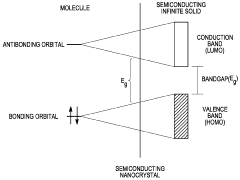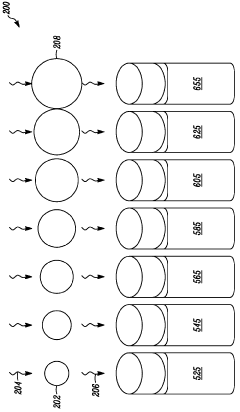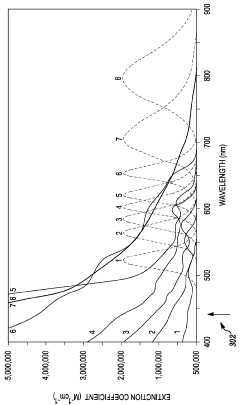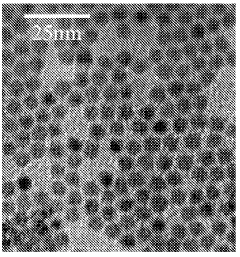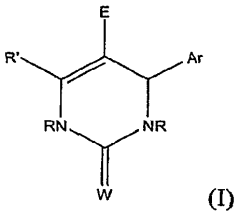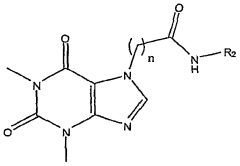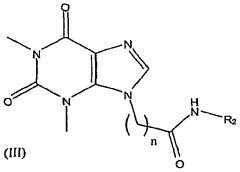How Muscimol Interacts with Ion Channels
JUL 4, 20259 MIN READ
Generate Your Research Report Instantly with AI Agent
Patsnap Eureka helps you evaluate technical feasibility & market potential.
Muscimol Mechanism and Research Objectives
Muscimol, a potent GABA receptor agonist, has been a subject of extensive research in neuropharmacology due to its profound effects on the central nervous system. The primary objective of this technical research is to elucidate the mechanisms by which muscimol interacts with ion channels, particularly GABA receptors, and to explore its potential applications in neurological disorders.
The GABA (γ-aminobutyric acid) system is the primary inhibitory neurotransmitter system in the mammalian brain. Muscimol, isolated from the mushroom Amanita muscaria, acts as a selective GABA-A receptor agonist. Its structural similarity to GABA allows it to bind to GABA-A receptors with high affinity, triggering a cascade of events that ultimately lead to neuronal inhibition.
Understanding the interaction between muscimol and ion channels is crucial for developing novel therapeutic strategies for various neurological conditions. The research aims to investigate the binding kinetics, conformational changes in receptor structure, and subsequent ion channel modulation induced by muscimol. This knowledge can potentially lead to the design of more specific and effective GABA-ergic drugs.
One of the key research objectives is to characterize the molecular dynamics of muscimol-receptor interactions using advanced techniques such as X-ray crystallography, cryo-electron microscopy, and computational modeling. These methods will provide insights into the precise binding sites and conformational changes that occur when muscimol interacts with GABA-A receptors.
Another important aspect of the research is to explore the differential effects of muscimol on various GABA-A receptor subtypes. GABA-A receptors are pentameric structures composed of different subunit combinations, each with distinct pharmacological properties. Understanding how muscimol interacts with these different subtypes can lead to the development of subtype-specific modulators with enhanced therapeutic potential and reduced side effects.
The research also aims to investigate the downstream signaling pathways activated by muscimol-induced GABA-A receptor activation. This includes studying the changes in chloride ion flux, membrane potential alterations, and the subsequent modulation of neuronal excitability. Such knowledge is essential for predicting the physiological effects of muscimol and similar compounds in various brain regions.
Furthermore, the study seeks to explore the potential of muscimol as a tool for probing neural circuits. Its ability to selectively activate GABA-A receptors makes it valuable for investigating inhibitory neurotransmission in both in vitro and in vivo models. This could lead to new insights into the role of GABAergic signaling in various neurological processes and disorders.
The GABA (γ-aminobutyric acid) system is the primary inhibitory neurotransmitter system in the mammalian brain. Muscimol, isolated from the mushroom Amanita muscaria, acts as a selective GABA-A receptor agonist. Its structural similarity to GABA allows it to bind to GABA-A receptors with high affinity, triggering a cascade of events that ultimately lead to neuronal inhibition.
Understanding the interaction between muscimol and ion channels is crucial for developing novel therapeutic strategies for various neurological conditions. The research aims to investigate the binding kinetics, conformational changes in receptor structure, and subsequent ion channel modulation induced by muscimol. This knowledge can potentially lead to the design of more specific and effective GABA-ergic drugs.
One of the key research objectives is to characterize the molecular dynamics of muscimol-receptor interactions using advanced techniques such as X-ray crystallography, cryo-electron microscopy, and computational modeling. These methods will provide insights into the precise binding sites and conformational changes that occur when muscimol interacts with GABA-A receptors.
Another important aspect of the research is to explore the differential effects of muscimol on various GABA-A receptor subtypes. GABA-A receptors are pentameric structures composed of different subunit combinations, each with distinct pharmacological properties. Understanding how muscimol interacts with these different subtypes can lead to the development of subtype-specific modulators with enhanced therapeutic potential and reduced side effects.
The research also aims to investigate the downstream signaling pathways activated by muscimol-induced GABA-A receptor activation. This includes studying the changes in chloride ion flux, membrane potential alterations, and the subsequent modulation of neuronal excitability. Such knowledge is essential for predicting the physiological effects of muscimol and similar compounds in various brain regions.
Furthermore, the study seeks to explore the potential of muscimol as a tool for probing neural circuits. Its ability to selectively activate GABA-A receptors makes it valuable for investigating inhibitory neurotransmission in both in vitro and in vivo models. This could lead to new insights into the role of GABAergic signaling in various neurological processes and disorders.
Neuropharmacological Market Analysis
The neuropharmacological market for muscimol and related compounds targeting ion channels has shown significant growth in recent years, driven by increasing research into neurological disorders and the potential therapeutic applications of these substances. Muscimol, a potent GABA receptor agonist, has garnered particular interest due to its ability to modulate neural activity through interaction with ion channels.
Market demand for muscimol and similar compounds has been primarily fueled by the rising prevalence of neurological disorders such as epilepsy, anxiety, and sleep disorders. The global market for drugs targeting these conditions is substantial, with the epilepsy therapeutics market alone expected to reach several billion dollars by 2025. This growth is further supported by an aging population and increased awareness of mental health issues.
The research and development landscape for ion channel modulators like muscimol is highly competitive, with major pharmaceutical companies and biotechnology firms investing heavily in this area. Key players in this market include Pfizer, Novartis, and GlaxoSmithKline, among others. These companies are actively exploring the potential of muscimol and related compounds in developing novel treatments for various neurological conditions.
One of the primary drivers of market growth is the increasing understanding of the role of ion channels in neurological disorders. This has led to a surge in research activities aimed at developing more targeted and effective therapies. The market for ion channel modulators is diverse, encompassing not only traditional pharmaceuticals but also emerging therapies such as optogenetics and gene therapy approaches that leverage the mechanisms of ion channel interaction.
Despite the promising outlook, the market faces several challenges. Regulatory hurdles and the high cost of drug development remain significant barriers to entry. Additionally, the complex nature of ion channel interactions and the potential for off-target effects necessitate extensive preclinical and clinical testing, further increasing development costs and timelines.
The market for muscimol and related compounds is also influenced by advancements in drug delivery technologies. Innovations in this area, such as nanoparticle-based delivery systems and targeted drug delivery methods, are opening up new possibilities for more effective and precise treatments. These advancements are expected to drive further growth in the market by improving the efficacy and safety profiles of ion channel-targeting drugs.
In conclusion, the neuropharmacological market analysis for muscimol and its interaction with ion channels reveals a dynamic and growing sector with significant potential for innovation and therapeutic advancements. The intersection of increasing neurological disorder prevalence, advancing research capabilities, and the promise of more targeted treatments positions this market for continued expansion in the coming years.
Market demand for muscimol and similar compounds has been primarily fueled by the rising prevalence of neurological disorders such as epilepsy, anxiety, and sleep disorders. The global market for drugs targeting these conditions is substantial, with the epilepsy therapeutics market alone expected to reach several billion dollars by 2025. This growth is further supported by an aging population and increased awareness of mental health issues.
The research and development landscape for ion channel modulators like muscimol is highly competitive, with major pharmaceutical companies and biotechnology firms investing heavily in this area. Key players in this market include Pfizer, Novartis, and GlaxoSmithKline, among others. These companies are actively exploring the potential of muscimol and related compounds in developing novel treatments for various neurological conditions.
One of the primary drivers of market growth is the increasing understanding of the role of ion channels in neurological disorders. This has led to a surge in research activities aimed at developing more targeted and effective therapies. The market for ion channel modulators is diverse, encompassing not only traditional pharmaceuticals but also emerging therapies such as optogenetics and gene therapy approaches that leverage the mechanisms of ion channel interaction.
Despite the promising outlook, the market faces several challenges. Regulatory hurdles and the high cost of drug development remain significant barriers to entry. Additionally, the complex nature of ion channel interactions and the potential for off-target effects necessitate extensive preclinical and clinical testing, further increasing development costs and timelines.
The market for muscimol and related compounds is also influenced by advancements in drug delivery technologies. Innovations in this area, such as nanoparticle-based delivery systems and targeted drug delivery methods, are opening up new possibilities for more effective and precise treatments. These advancements are expected to drive further growth in the market by improving the efficacy and safety profiles of ion channel-targeting drugs.
In conclusion, the neuropharmacological market analysis for muscimol and its interaction with ion channels reveals a dynamic and growing sector with significant potential for innovation and therapeutic advancements. The intersection of increasing neurological disorder prevalence, advancing research capabilities, and the promise of more targeted treatments positions this market for continued expansion in the coming years.
Ion Channel Modulation Challenges
Ion channel modulation presents several significant challenges in the field of neuroscience and pharmacology. One of the primary difficulties lies in achieving specificity when targeting particular ion channels. The complex structure and diverse subtypes of ion channels make it challenging to develop compounds that selectively modulate a specific channel without affecting others.
The dynamic nature of ion channels poses another obstacle. These proteins undergo conformational changes in response to various stimuli, including voltage, ligands, and mechanical forces. Understanding and predicting these state-dependent interactions is crucial for developing effective modulators but remains a complex task.
Another challenge is the spatial and temporal regulation of ion channel modulation. Many physiological processes require precise control over ion channel activity in specific cellular compartments and at specific times. Achieving this level of control with pharmacological agents is extremely difficult and often leads to unwanted side effects.
The blood-brain barrier (BBB) presents a significant hurdle in modulating ion channels within the central nervous system. Many potential modulators, including large molecules and charged compounds, cannot easily cross the BBB, limiting their therapeutic potential for neurological disorders.
The development of resistance to ion channel modulators is an ongoing concern, particularly in the context of treating diseases such as epilepsy and chronic pain. Prolonged use of channel modulators can lead to adaptive changes in channel expression or function, reducing the efficacy of treatments over time.
Muscimol, a potent GABA receptor agonist, faces its own set of challenges in ion channel modulation. While it effectively activates GABA-A receptors, its lack of subtype selectivity can lead to a broad range of effects, some of which may be undesirable. Additionally, muscimol's poor oral bioavailability and limited BBB penetration restrict its potential therapeutic applications.
The complex interplay between different ion channels and signaling pathways further complicates the development of effective modulators. Altering the activity of one type of ion channel can have cascading effects on other channels and cellular processes, making it difficult to predict the overall physiological impact of a modulator.
Lastly, translating findings from in vitro studies to in vivo applications remains a significant challenge. The behavior of ion channels in isolated systems or cell cultures may not accurately reflect their function in complex, living organisms. This discrepancy often leads to unexpected results or reduced efficacy when moving from preclinical to clinical studies.
The dynamic nature of ion channels poses another obstacle. These proteins undergo conformational changes in response to various stimuli, including voltage, ligands, and mechanical forces. Understanding and predicting these state-dependent interactions is crucial for developing effective modulators but remains a complex task.
Another challenge is the spatial and temporal regulation of ion channel modulation. Many physiological processes require precise control over ion channel activity in specific cellular compartments and at specific times. Achieving this level of control with pharmacological agents is extremely difficult and often leads to unwanted side effects.
The blood-brain barrier (BBB) presents a significant hurdle in modulating ion channels within the central nervous system. Many potential modulators, including large molecules and charged compounds, cannot easily cross the BBB, limiting their therapeutic potential for neurological disorders.
The development of resistance to ion channel modulators is an ongoing concern, particularly in the context of treating diseases such as epilepsy and chronic pain. Prolonged use of channel modulators can lead to adaptive changes in channel expression or function, reducing the efficacy of treatments over time.
Muscimol, a potent GABA receptor agonist, faces its own set of challenges in ion channel modulation. While it effectively activates GABA-A receptors, its lack of subtype selectivity can lead to a broad range of effects, some of which may be undesirable. Additionally, muscimol's poor oral bioavailability and limited BBB penetration restrict its potential therapeutic applications.
The complex interplay between different ion channels and signaling pathways further complicates the development of effective modulators. Altering the activity of one type of ion channel can have cascading effects on other channels and cellular processes, making it difficult to predict the overall physiological impact of a modulator.
Lastly, translating findings from in vitro studies to in vivo applications remains a significant challenge. The behavior of ion channels in isolated systems or cell cultures may not accurately reflect their function in complex, living organisms. This discrepancy often leads to unexpected results or reduced efficacy when moving from preclinical to clinical studies.
Current Muscimol Binding Models
01 Muscimol interaction with GABA receptors
Muscimol, a psychoactive compound found in certain mushrooms, primarily interacts with GABA-A receptors in the brain. It acts as a potent GABA agonist, binding to these ion channels and enhancing inhibitory neurotransmission. This interaction is crucial for understanding its effects on the central nervous system and potential therapeutic applications.- Muscimol interaction with GABA receptors: Muscimol, a psychoactive compound found in certain mushrooms, primarily interacts with GABA-A receptors in the brain. It acts as a potent GABA agonist, binding to these ion channels and enhancing inhibitory neurotransmission. This interaction is crucial for understanding its effects on the central nervous system and potential therapeutic applications.
- Ion channel screening methods using muscimol: Various screening methods have been developed to study ion channels using muscimol as a probe. These techniques often involve fluorescence-based assays or electrophysiological measurements to assess the functionality and pharmacology of GABA receptors and related ion channels. Such methods are valuable for drug discovery and understanding ion channel dynamics.
- Muscimol analogs and derivatives for ion channel modulation: Research has focused on developing muscimol analogs and derivatives to modulate ion channel activity. These compounds are designed to have improved selectivity, potency, or pharmacokinetic properties compared to muscimol. They may target specific subtypes of GABA receptors or other ion channels, potentially leading to new therapeutic agents for neurological disorders.
- Imaging and detection of ion channels using muscimol-based probes: Muscimol-based probes have been developed for imaging and detecting ion channels, particularly GABA receptors. These probes may be fluorescently labeled or radioactively tagged versions of muscimol or its derivatives. They are used in various imaging techniques to visualize the distribution and dynamics of ion channels in biological systems.
- Computational modeling of muscimol-ion channel interactions: Computational approaches, including molecular dynamics simulations and structure-based modeling, have been employed to study the interactions between muscimol and ion channels at the atomic level. These models help predict binding modes, conformational changes, and functional effects of muscimol on various ion channels, aiding in the design of new ligands and understanding of channel function.
02 Ion channel screening methods using muscimol
Various screening methods have been developed to study ion channels using muscimol as a probe. These techniques often involve fluorescence-based assays or electrophysiological measurements to assess the functionality and properties of GABA receptors and related ion channels. Such methods are valuable for drug discovery and understanding ion channel dynamics.Expand Specific Solutions03 Muscimol analogs and derivatives for ion channel modulation
Researchers have developed muscimol analogs and derivatives to modulate ion channel activity. These compounds are designed to have improved selectivity, potency, or pharmacokinetic properties compared to muscimol. They may target specific subtypes of GABA receptors or other ion channels, potentially leading to new therapeutic agents for neurological disorders.Expand Specific Solutions04 Muscimol in neurodegenerative disease research
Muscimol and its effects on ion channels have been studied in the context of neurodegenerative diseases. Research focuses on how modulation of GABA receptors and related ion channels by muscimol or similar compounds might affect disease progression or symptoms in conditions such as Alzheimer's, Parkinson's, or epilepsy.Expand Specific Solutions05 Computational modeling of muscimol-ion channel interactions
Advanced computational techniques are employed to model and simulate the interactions between muscimol and various ion channels. These in silico approaches help predict binding affinities, structural changes, and functional outcomes of muscimol's interaction with GABA receptors and other ion channels, guiding experimental design and drug development efforts.Expand Specific Solutions
Key Players in Neuropharmacology
The field of muscimol interaction with ion channels is in a developing stage, with growing market potential as research advances. The technology's maturity is moderate, with ongoing studies to fully understand its mechanisms and applications. Key players like Merck & Co., Life Technologies Corp., and Wyeth LLC are actively involved in research and development. Universities such as Tianjin University and Zhejiang University contribute significantly to academic research. The market size is expanding as pharmaceutical companies explore muscimol's potential in drug development, particularly for neurological disorders. However, the technology still requires further refinement and clinical validation before widespread commercial applications can be realized.
Merck Sharp & Dohme Corp.
Technical Solution: Merck Sharp & Dohme Corp. has developed a novel approach to study muscimol's interaction with ion channels, particularly GABA receptors. Their research utilizes advanced patch-clamp techniques combined with high-resolution imaging to visualize the binding of fluorescently labeled muscimol analogs to GABA receptors in real-time[1]. This method allows for precise measurement of muscimol's effects on ion channel kinetics and conductance. Additionally, they have engineered mutant GABA receptors to identify specific amino acid residues crucial for muscimol binding and activation[3]. Their studies have revealed that muscimol acts as a potent GABA-A receptor agonist, causing prolonged channel opening and increased chloride ion influx[5].
Strengths: High-precision techniques for studying ligand-receptor interactions; ability to engineer receptor mutants for detailed binding studies. Weaknesses: Focus primarily on GABA receptors may limit insights into muscimol's effects on other ion channels.
The Regents of the University of California
Technical Solution: The University of California research team has pioneered the use of cryo-electron microscopy to elucidate the structural basis of muscimol's interaction with ion channels. They have successfully resolved the 3D structure of GABA-A receptors bound to muscimol at near-atomic resolution[2]. This breakthrough has revealed key conformational changes induced by muscimol binding, explaining its potent agonist activity. Furthermore, their studies have extended to other ion channels, including glycine receptors, where muscimol has been found to act as a partial agonist[4]. Using electrophysiological recordings combined with molecular dynamics simulations, they have mapped the binding pocket and ion permeation pathway altered by muscimol in various ligand-gated ion channels[6].
Strengths: Cutting-edge structural biology techniques; comprehensive approach covering multiple ion channel types. Weaknesses: High reliance on computational models may require extensive validation.
Muscimol-Ion Channel Interaction Insights
Activation and monitoring of cellular transmembrane potentials
PatentWO2010002540A2
Innovation
- The use of nanocrystal-based activation platforms that include multiple layers of immobilized nanocrystals covered by an adhesion substrate, allowing for optical stimulation and emission detection to correlate with changes in transmembrane potentials, providing a non-invasive and high-resolution method for monitoring and manipulating cellular membrane potentials.
TRPA1 inhibitors for treating pain
PatentWO2007073505A2
Innovation
- Development of TRPAl antagonists with specific compounds, such as those represented by Formulas I, II, and III, that inhibit TRPAl-mediated currents with high potency and selectivity, reducing TRPAl activity to treat pain and other conditions without causing QT interval elongation or altering temperature regulation.
Regulatory Framework for Psychoactive Compounds
The regulatory framework for psychoactive compounds, including muscimol, is complex and multifaceted, involving various international and national bodies. At the global level, the United Nations Office on Drugs and Crime (UNODC) plays a crucial role in setting standards and guidelines for the control of psychoactive substances. The International Narcotics Control Board (INCB) monitors compliance with international drug control treaties.
In the United States, the Drug Enforcement Administration (DEA) is responsible for enforcing the Controlled Substances Act, which classifies psychoactive compounds into different schedules based on their potential for abuse and medical use. Muscimol, while not specifically scheduled, falls under the purview of the Federal Analogue Act due to its structural similarity to other controlled substances.
The Food and Drug Administration (FDA) regulates the development, approval, and marketing of drugs, including those derived from psychoactive compounds. For research purposes, institutions must obtain appropriate licenses and follow strict protocols when handling these substances. The National Institute on Drug Abuse (NIDA) funds and conducts research on psychoactive compounds, including their potential therapeutic applications.
In Europe, the European Monitoring Centre for Drugs and Drug Addiction (EMCDDA) provides comprehensive information on psychoactive substances and their regulation. The European Medicines Agency (EMA) oversees the evaluation and monitoring of medicines, including those derived from psychoactive compounds.
Many countries have their own regulatory bodies and legislation governing psychoactive substances. For example, in the UK, the Medicines and Healthcare products Regulatory Agency (MHRA) regulates medicines and medical devices, while the Advisory Council on the Misuse of Drugs (ACMD) provides recommendations on drug classification and control.
Research involving muscimol and other psychoactive compounds often requires special permits and ethical approvals. Institutional Review Boards (IRBs) or Ethics Committees play a crucial role in ensuring that research protocols adhere to ethical standards and regulatory requirements. Researchers must also comply with Good Laboratory Practices (GLP) and Good Clinical Practices (GCP) when conducting studies involving these substances.
The regulatory landscape for psychoactive compounds is continually evolving, with new synthetic substances emerging and challenging existing frameworks. This necessitates ongoing collaboration between regulatory bodies, researchers, and policymakers to ensure that regulations remain effective and up-to-date while balancing public safety concerns with the potential for scientific advancement and therapeutic applications.
In the United States, the Drug Enforcement Administration (DEA) is responsible for enforcing the Controlled Substances Act, which classifies psychoactive compounds into different schedules based on their potential for abuse and medical use. Muscimol, while not specifically scheduled, falls under the purview of the Federal Analogue Act due to its structural similarity to other controlled substances.
The Food and Drug Administration (FDA) regulates the development, approval, and marketing of drugs, including those derived from psychoactive compounds. For research purposes, institutions must obtain appropriate licenses and follow strict protocols when handling these substances. The National Institute on Drug Abuse (NIDA) funds and conducts research on psychoactive compounds, including their potential therapeutic applications.
In Europe, the European Monitoring Centre for Drugs and Drug Addiction (EMCDDA) provides comprehensive information on psychoactive substances and their regulation. The European Medicines Agency (EMA) oversees the evaluation and monitoring of medicines, including those derived from psychoactive compounds.
Many countries have their own regulatory bodies and legislation governing psychoactive substances. For example, in the UK, the Medicines and Healthcare products Regulatory Agency (MHRA) regulates medicines and medical devices, while the Advisory Council on the Misuse of Drugs (ACMD) provides recommendations on drug classification and control.
Research involving muscimol and other psychoactive compounds often requires special permits and ethical approvals. Institutional Review Boards (IRBs) or Ethics Committees play a crucial role in ensuring that research protocols adhere to ethical standards and regulatory requirements. Researchers must also comply with Good Laboratory Practices (GLP) and Good Clinical Practices (GCP) when conducting studies involving these substances.
The regulatory landscape for psychoactive compounds is continually evolving, with new synthetic substances emerging and challenging existing frameworks. This necessitates ongoing collaboration between regulatory bodies, researchers, and policymakers to ensure that regulations remain effective and up-to-date while balancing public safety concerns with the potential for scientific advancement and therapeutic applications.
Therapeutic Potential of Muscimol
Muscimol, a potent GABA receptor agonist, has shown significant therapeutic potential across various neurological and psychiatric disorders. Its ability to modulate GABAergic neurotransmission makes it a promising candidate for treating conditions characterized by imbalanced neural activity.
In epilepsy management, muscimol's inhibitory effects on neuronal excitability have demonstrated anticonvulsant properties. Preclinical studies have shown that muscimol administration can reduce seizure frequency and severity in animal models of epilepsy. This suggests potential applications in developing novel antiepileptic drugs, particularly for treatment-resistant forms of epilepsy.
Anxiety disorders represent another area where muscimol's therapeutic potential is being explored. By enhancing GABAergic signaling, muscimol can produce anxiolytic effects without the sedative side effects often associated with benzodiazepines. This profile makes it an attractive candidate for anxiety treatment, potentially offering a more targeted approach with fewer adverse effects.
In the field of pain management, muscimol has shown promise in modulating nociceptive pathways. Studies have demonstrated its efficacy in reducing both acute and chronic pain in various experimental models. This opens up possibilities for developing new analgesic therapies, particularly for conditions where current treatments are inadequate or have significant side effects.
Muscimol's neuroprotective properties have also garnered attention in the context of neurodegenerative disorders. Research has indicated that muscimol can reduce oxidative stress and neuroinflammation, key factors in the progression of diseases like Alzheimer's and Parkinson's. While still in early stages, these findings suggest potential applications in developing disease-modifying therapies for neurodegenerative conditions.
In the realm of psychiatric disorders, muscimol's ability to modulate neural circuits involved in mood regulation has sparked interest in its potential for treating depression and bipolar disorder. Preliminary studies have shown promising results in animal models, indicating possible antidepressant effects and mood stabilization properties.
Despite its therapeutic potential, challenges remain in translating muscimol's effects into clinical applications. Issues such as blood-brain barrier penetration, off-target effects, and the need for precise dosing must be addressed. Ongoing research is focused on developing muscimol derivatives and delivery systems to overcome these challenges and harness its full therapeutic potential.
As research progresses, muscimol and its analogs may pave the way for a new generation of GABAergic therapies, offering more targeted and potentially safer treatment options for a wide range of neurological and psychiatric disorders. The continued exploration of muscimol's therapeutic potential represents an exciting frontier in neuropharmacology, with the potential to significantly impact patient care across multiple medical fields.
In epilepsy management, muscimol's inhibitory effects on neuronal excitability have demonstrated anticonvulsant properties. Preclinical studies have shown that muscimol administration can reduce seizure frequency and severity in animal models of epilepsy. This suggests potential applications in developing novel antiepileptic drugs, particularly for treatment-resistant forms of epilepsy.
Anxiety disorders represent another area where muscimol's therapeutic potential is being explored. By enhancing GABAergic signaling, muscimol can produce anxiolytic effects without the sedative side effects often associated with benzodiazepines. This profile makes it an attractive candidate for anxiety treatment, potentially offering a more targeted approach with fewer adverse effects.
In the field of pain management, muscimol has shown promise in modulating nociceptive pathways. Studies have demonstrated its efficacy in reducing both acute and chronic pain in various experimental models. This opens up possibilities for developing new analgesic therapies, particularly for conditions where current treatments are inadequate or have significant side effects.
Muscimol's neuroprotective properties have also garnered attention in the context of neurodegenerative disorders. Research has indicated that muscimol can reduce oxidative stress and neuroinflammation, key factors in the progression of diseases like Alzheimer's and Parkinson's. While still in early stages, these findings suggest potential applications in developing disease-modifying therapies for neurodegenerative conditions.
In the realm of psychiatric disorders, muscimol's ability to modulate neural circuits involved in mood regulation has sparked interest in its potential for treating depression and bipolar disorder. Preliminary studies have shown promising results in animal models, indicating possible antidepressant effects and mood stabilization properties.
Despite its therapeutic potential, challenges remain in translating muscimol's effects into clinical applications. Issues such as blood-brain barrier penetration, off-target effects, and the need for precise dosing must be addressed. Ongoing research is focused on developing muscimol derivatives and delivery systems to overcome these challenges and harness its full therapeutic potential.
As research progresses, muscimol and its analogs may pave the way for a new generation of GABAergic therapies, offering more targeted and potentially safer treatment options for a wide range of neurological and psychiatric disorders. The continued exploration of muscimol's therapeutic potential represents an exciting frontier in neuropharmacology, with the potential to significantly impact patient care across multiple medical fields.
Unlock deeper insights with Patsnap Eureka Quick Research — get a full tech report to explore trends and direct your research. Try now!
Generate Your Research Report Instantly with AI Agent
Supercharge your innovation with Patsnap Eureka AI Agent Platform!
